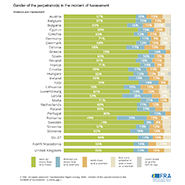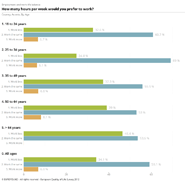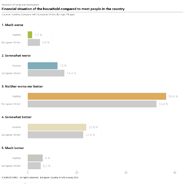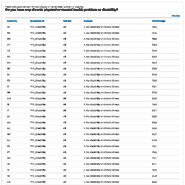EU LGBTIQ Survey III
Different visualisation tools
This interactive tool offers different ways to explore the data behind the survey results. There are four main visualisation options: Map, Bar chart, Country detail and Countries comparison, as well as a Table option that shows the data for the selected visualisation.
Map

The map visualisation presents an overview of the results for covered EU Member States as well as North Macedonia, Serbia, the EU-8 Total (covered EU Member States) and Total (all covered countries) for individual answer category selected by the user.
Bar chart

The Bar chart visualisation illustrates the results for covered EU Member States, North Macedonia, Serbia, the EU-8 Total (covered EU Member States) and Total (all covered countries) as a vertical stacked bar chart with all answer categories.
Country detail

The Country detail visualisation presents the values for all answer categories for the selected country, survey question and subset of respondents.
Countries comparison

The Countries comparison visualisation presents a comparative overview of the results for at least two selected countries. Country results can also be compared with the EU-8 Total (covered EU Member States) or Total (all survey countries) across answer categories.
Data table

The Table presents the data of the selected visualisation in a numerical format.
How to explore the data
The survey questions are divided into six topics and each topic has a number of questions. Choose a topic, then a question from the drop-down list in the grey box. You can also apply additional filters. You can also change the visualisation using the list of options on the right hand side of the chart or map.
How to export the data
The export options can be accessed via the Export button. To export the visualisation as an image, choose one of Figure (PNG), FSVG (High resolution), EPS (High resolution) or PDF (High resolution). To export the data for the selected visualisation in Microsoft Excel format, choose XLSX. To generate a Page URL or Embeddable HTML choose the corresponding option.
The third iteration of the EU LGBTIQ Survey of the European Union Agency for Fundamental Rights (FRA), was conducted in 2023 after the first wave of the survey in 2012 and the second wave in 2019. It presents the experiences of LGBTIQ people across the EU 27 Member States, and the candidate countries Albania, North Macedonia and Serbia, on the extent to which they enjoy fundamental rights. It provides policymakers with a solid empirical basis for evidence-based policies to ensure respect and protection for and fulfilment of the fundamental rights of LGBTIQ people. The survey report 'LGBTIQ at a crossroads: progress and challenges' was published on 14 May 2024. The report is complemented by this interactive data explorer which shows data for over 150 questions and contains many options for filtering the data.
Sexual orientation, and gender identity and expression are basic elements of personal identity. In the EU today, many of those with a sexual orientation, such as lesbian, gay, bisexual, asexual or pansexual, and/or a certain gender identity, trans women and men, non-binary and gender diverse people, and intersex people with diverse sex characteristics or gender expression suffer discrimination, harassment and violence or isolation and exclusion because of who they are. To protect themselves they often feel the need and the pressure to conceal or hide their sexual orientation, gender identity or sex characteristics.
The survey was conducted online from 2 June to 22 August 2023. The questionnaire covered a wide range of issues, such as experiences of discrimination, harassment or violence, rights awareness, openness about being LGBTIQ, positive and negative life experiences at work and in education, socioeconomic and living conditions, healthcare, mental health and wellbeing, as well as housing and homelessness. The data were weighted to take account of differences in the estimated size of each LGBTI group in each survey country and by age group, based on information on the LGBTI population from previous LGBTI surveys by various institutions and organisations in the EU. In addition, the data were weighted to account for the respondents’ affiliation with LGBTI organisations and whether they had participated in other LGBTI surveys (including FRA’s LGBT survey of 2012).
The survey provides the data necessary to assess the implementation and impact of EU law as it relates to LGBTIQ people. This includes the directive on equal treatment in employment and occupation (Council Directive 2000/78/ EC), the directive on the implementation of the principle of equal opportunities and equal treatment of men and women in matters of employment and occupation (recast) (Directive 2006/54/EC), and the victims’ rights directive (Directive 2012/29/EU).
Who are the respondents?
In this survey, each respondent provided their own ‘SO-GIE-SC’ profile based on their sexual orientation (SO), gender identity and expression (GIE) and sex characteristics (SC). This report employs an intersectional approach disaggregating relevant indicators by sexual orientation, gender identity and sex characteristics, as well as by age, disability, socioeconomic and employment status, belonging to a minority group and educational attainment (5).
Each survey respondent selected what best describes them in terms of sexual orientation, gender identity and sex characteristics. Individual respondents could identify as belonging to more than one of these groups. In analysing and presenting the findings, FRA uses both the larger groupings used in previous surveys and a breakdown of respondents based on their sexual orientation and/or gender identity and/or sex characteristics for certain findings that are significant for some respondent groups with intersectional SO-GIE-SC identities.
Key concepts and terminology
The following glossary helps navigate the different terms and concepts used to explain the survey respondents’ profiles and their multiple and intersecting identities. The reader is also encouraged to consult the Guidance note on the collection and use of data for LGBTIQ equality, prepared by the Subgroup on Equality Data of the High-Level group on non-discrimination, equality and diversity and published by the European Commission in March 2023.
Sexual orientation (SO)
- Sexual orientation encompasses ‘each person’s capacity for profound emotional, affectional and sexual attraction to, and intimate and sexual relations with, individuals of a different gender or the same gender or more than one gender’. Sexual orientation refers to identity (being), conduct (behaviour) and how you relate to other people (relationships).
- Yogyakarta Principles: Principles on the application of international human rights law in relation to sexual orientation and gender identity, March 2007, p. 6.
- Heteronormativity is the assumption of heterosexuality as the social norm. It involves the assumption that everyone is ‘naturally’ heterosexual.
- EIGE (European Institute for Gender Equality), ‘Glossary & thesaurus’.
- Heterosexual refers to a person who identifies as a man who is sexually and/or emotionally attracted only to people who identify as women or a person who identifies as a woman who is sexually and/or emotionally attracted only to people who identify as men.
- ILGA-Europe (International Lesbian, Gay, Bisexual, Trans and Intersex Association – Europe) (2022), ‘Glossary’.
- Gay refers to a person who is sexually and/or emotionally attracted to people of the same gender. It traditionally refers to men, but other people who are attracted to people of the same gender or of multiple genders may also define themselves as gay.
- EIGE, ‘Glossary & thesaurus’.
- Lesbian refers to a woman who is sexually and/or emotionally attracted to women (*). Some non-binary people may also identify with this term (**).
- (*) ILGA-Europe (2022), ‘Glossary’.
- (**) As reported in European Commission (2023), Guidance note on the collection and use of data for LGBTIQ equality, p. 52, referring to Stonewall (2022), ‘List of LGBTQ+ terms’.
- Bisexual refers to a person who is emotionally and/or sexually attracted to people of more than one gender.
- ILGA-Europe (2022), ‘Glossary’.
- Pansexual refers to a person who is emotionally and/or sexually attracted to people regardless of their gender.
- ILGA-Europe (2022), ‘Glossary’.
- Asexual refers to a person who does not experience sexual attraction. Some asexual people experience romantic attraction, while others do not. Asexual people who experience romantic attraction might also use terms such as gay, bi, lesbian, straight and queer in conjunction with asexual to describe the direction of their romantic attraction.
- Stonewall (2022), ‘List of LGBTQ+ terms’.
Gender identity and expression (GIE)
- Cisgender refers to a person who does not identify as trans (*) or non-binary and whose current gender identity corresponds to the sex they were assigned at birth (**).
- (*) ILGA-Europe (2022), ‘Glossary’.
- (**) National Academies of Sciences, Engineering, and Medicine (2022), Measuring Sex, Gender Identity, and Sexual Orientation, The National Academies Press, Washington, DC, p. 4.
- Gender identity refers to ‘each person’s deeply felt internal and individual experience of gender’. This ‘may or may not correspond with the sex assigned at birth, including the personal sense of the body (which may involve, if freely chosen, modification of bodily appearance or function by medical, surgical or other means) and other expressions of gender, including dress, speech and mannerisms’.
- ILGA-Europe (2022), ‘Glossary’.
- Gender expression is the presentation of a person’s gender through physical appearance – including dress, hairstyle, accessories, cosmetics – and mannerisms, speech, behavioural patterns, names and personal references. Gender expression may or may not align with a person’s gender identity.
- Yogyakarta Principles: Principles on the application of international human rights law in relation to sexual orientation and gender identity, March 2007, p. 6.
- Trans is an umbrella term that includes people who have a gender identity that is different from their gender assigned at birth. It may include but is not limited to people who identify as transsexual, transgender, transvestite/ cross-dressing, androgyne, polygender, genderqueer, gender-variant and gender non-conforming people, or people with any other gender identity and/or expression that does not meet the societal and cultural expectations placed on gender identity.
- ILGA-Europe (2022), ‘Glossary’.
- Non-binary ‘refers to gender identities other than male or female’.
- ILGA-Europe (2022), ‘Glossary’.
Sex characteristics – intersex and endosex (SC)
- Intersex people are born with sex characteristics (sexual anatomy, reproductive organs, hormonal structure and/or levels and/or chromosomal patterns) that do not fit the typical definition of male or female. The term ‘intersex’ is an umbrella term for the spectrum of variations in sex characteristics that occur naturally. The term intersex acknowledges that, physically, sex is a spectrum and that people with variations in sex characteristics other than male or female exist.
- Endosex is ‘a term describing a person who was born with sex characteristics that fit typical binary notions of male or female bodies. An endosex person may identify with any gender identity or sexual orientation.’.
- IOM (International Organization for Migration) (2021), ‘SOGIESC full glossary of terms’, p. 7.
- Queer is an umbrella term encompassing people belonging to the LGBTIQ community, which may refer to any or all SO-GIE-SC elements. Previously used as a derogatory term in English, ‘queer’ has been reclaimed by those who identify beyond traditional gender categories and heteronormative social norms. However, depending on the context, some people may still find it offensive.
- TGEU (Transgender Europe), ‘Glossary’, and ILGA-Europe (2022), ‘Glossary’.
Intersectionality
EIGE defines intersectionality as ‘ways in which sex and gender intersect with other personal characteristics/identities, and how these intersections contribute to unique experiences of discrimination’ (*).
This report adopts an intersectional approach, disaggregating respondents by sexual orientation, gender identity and sex characteristics (SO-GIE-SC) as well as by age, gender, disability, socioeconomic and employment status, educational attainment and belonging to a minority group. By doing so, it shows how experiences of discrimination or victimisation might result from multiple and intersecting layers of identities as perceived by the respondents and others.
An intersectional approach helps analyse situations in which several grounds for discrimination operate concurrently, producing a multiplier or compounding effect (**).
(*) EIGE, ‘Glossary & thesaurus’.
(**) See also the Yogyakarta Principles plus 10 (2017), Additional principles and state obligations on the application of international human rights law in relation to sexual orientation, gender identity, gender expression and sex characteristics to complement the Yogyakarta Principles, as adopted on 10 November, Geneva.
The FRA data visualization tool is designed to work in all modern browsers such as Google Chrome, Apple Safari, Mozilla's Firefox and Microsoft Edge. If you are using an old browser such Internet Explorer 11 or earlier, we recommend that you either upgrade to Edge or use instead the latest version of one of the other browsers listed above.
Accessibility
We are committed to making this site as accessible as possible for all users, including those with disabilities. For more details, please see our accessibility section.